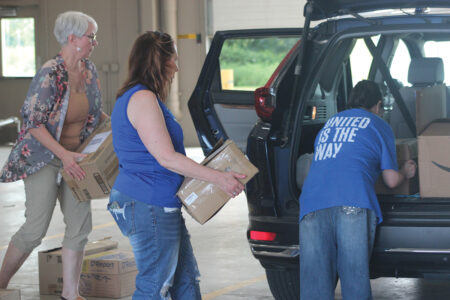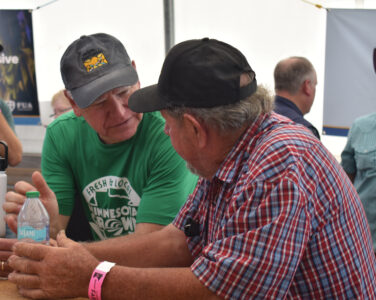Talking health and safety at Farmfest
Wellness Pavilion includes farm safety, first aid resources

Courtney Spence checked to see how Arnold Jibben was doing as he tried out a simulator designed to show the amount of force needed to lift a person trapped in grain. The grain bin simulator was one of several different hands-on health and safety demonstrations at the UMASH Wellness Pavilion at Farmfest.
GILFILLAN ESTATE — Farming can be hazardous work. And this week, some of the exhibitors at Farmfest were helping people learn more about how to stay safe, or even save a life.
On Thursday, Hayden Larson and Arnold Jibben each took turns pulling up on a rope, that was part of a simulator designed to show how much force it takes to lift someone trapped in a grain bin.
“I think it’s eye-opening for people. People don’t realize how much it takes,” Jibben said. Pulling a 165-pound person out of just three feet of grain takes about 325 pounds of force, said Courtney Spence, of the Minnesota State Southern Agricultural Center of Excellence.
This week, the UMASH (Upper Midwest Agricultural Safety and Health Center) Wellness Pavilion at Farmfest brought together a group of exhibitors with resources on topics ranging from mental health to first aid and farm safety.
Ann Jenson, of Southwest Minnesota EMS, said a lot of people had come through the pavilion during Farmfest. Jenson was at the “Stop the Bleed” table, teaching visitors ways to control bleeding when a person is seriously injured.
“It’s been very busy,” Jenson said. “I think we gave 100 (Stop the Bleed) kits away yesterday.”
A hands-on demonstration using a dummy gave visitors a chance to practice packing a “wound” with gauze, and applying a tourniquet. “We want people to know it’s OK to put a tourniquet on,” Jenson said.
An event like Farmfest was an opportunity to share important health information and resources, Jenson said. On farms and in rural settings, there are many ways a person can be wounded in an accident. Accidents involving grain augers and hunting accidents were two examples of situations in which taking action to control bleeding can help save a person’s life, she said.
“Machinery keeps getting bigger, and it’s faster, so safety keeps getting more important, I feel,” Jenson said.
Natalie Mohr, who was serving with the HeartCorps public health program, said skills like CPR were also valuable for rural residents.
“Most cardiac arrests happen out of the hospital,” she said. When bystanders take action to do CPR, it can increase a person’s chances for survival. In rural areas where it might take time for medical responders to arrive, that makes a difference, Mohr said.
On Thursday, Mohr was teaching visitors like Makayla Howard how to perform CPR. Using a dummy, Mohr guided Howard through the steps of CPR, and even taught her to how to use the rhythm of the “Baby Shark” song to do chest compressions.
“I feel good, because I can help someone,” Howard said of taking part in the demonstration.
Jibben said he thought raising awareness of farm safety issues was an important part of the demonstrations. Jibben, a Twin Brooks, S.D., resident, said he had a neighbor who died as the result of a grain bin accident. It was important that people talk about safety, he said. “There’s a stigma that needs to be broken down, almost.”
Jenson said it was positive seeing the people who came to visit booths at the UMASH pavilion.
“It’s amazing, the number of high school kids who stop and watch” the demonstrations, she said. “It’s a great way to reach out to people.”



